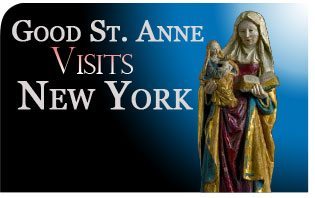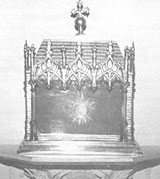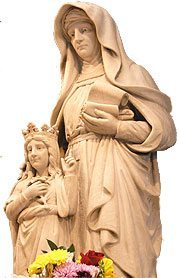 Unheralded and unexpected, Bishop Marquis arrived at the rectory of Saint Jean Baptiste in New York City on a Sunday morning, May 1, 1892. Traveling from Rome to Quebec, he had stopped in New York to rest before continuing his trip.
Unheralded and unexpected, Bishop Marquis arrived at the rectory of Saint Jean Baptiste in New York City on a Sunday morning, May 1, 1892. Traveling from Rome to Quebec, he had stopped in New York to rest before continuing his trip.
No sooner did Fr. Frederick Tetreau and his assistants learn of the prelate’s mission — he was the bearer of a relic of Saint Anne, solicited from His Holiness Pope Leo XIII by the Cardinal-Archbishop of Quebec — than they begged him to allow this sacred treasure to be exposed for the veneration of the faithful during the evening’s Vespers service. Since the bishop was not scheduled to leave for Quebec until the next day, he consented and the reliquary was taken to the church.
The relic, a fragment of the wrist of Saint Anne, which showed the joint near the thumb, was some two or three inches in length, with the skin and flesh still adhering to the bone.

The very sight of the reliquary, which displayed the polished point of the wrist bone with its adherent flesh, made a deep impression on the priests. During the interval between Mass and Vespers, the news spread that the faithful would have an opportunity to venerate the relic, and the church soon became crowded with the sick and suffering who came with others to kiss the reliquary and to beseech “good Saint Anne,” as she is fondly called in France and Canada, to obtain cures from God.
As a writer in one of the great daily papers expressed it, this relic brought one very near the person of Our Lord, since it enabled one to touch not merely the garment of Saint Anne, but her very flesh.
From the crowd, a young epileptic approached the communion railing and fell into fearful convulsions. Eyewitnesses relate that it took the strength of several men to hold the boy down, but, as soon as the priest touched him with the reliquary, the convulsions ceased.
The sudden cessation of the epileptic spasms struck those present with awe, and word of the prodigy spread rapidly to other parts. The eager crowds of visitors thronged to the church long after Vespers. All through that day and the next and the next, and far into the night, a living stream of petitioners filled the usually quiet and out-of-the-way little church.
In face of such a reaction, the reluctant Bishop Marquis was persuaded to remain in New York a few days longer.
He felt he could not disappoint the multitudes of the believing and the distressed. The ecclesiastical authorization was obtained, and the relic was exposed throughout the week, with the devotion constantly increasing.
Thus passed the first and then the second week of May. It is calculated that 200,000 to 300,000 venerated the relic during these weeks.
The multitudes who came continued to increase day by day on into the third week. Bands of men and women, several groups led by their priests, from the New England and mid-Atlantic states — from Boston, Philadelphia, Scranton, Pittsburgh, Baltimore — were moved by a holy impulse to come and venerate the relic. Letters arrived from the South and West, from Louisiana, Utah, Iowa, Nebraska, Wisconsin and Minnesota, earnestly beseeching Bishop Marquis to delay his departure for Canada yet another week.
This, however, was impossible. It was announced that May 20 would be the last day of the relic’s stay. There was no means of keeping an accurate account of the numbers and names of those who were daily said to be cured. All the events of these three weeks had been absolutely unplanned and unexpected. No one had registered the names or circumstances of cures attributed to the relic, although several pairs of crutches and spectacles remained near the sanctuary in silent testimony.
Thursday, May 19 was a dark, stormy day; heavy rain and hail fell without intermission, and a fierce easterly wind lashed the streets, making it difficult for even the strongest passersby to hold up their umbrellas. Nonetheless, from five in the morning until ten at night, the street in front of the church, from Third to Lexington Avenues, was thronged with pilgrims. The sidewalks in front of and behind the church were densely packed with those who braved the elements to await entry into the church. On the opposite side of the street stood hundreds more. It was a sight never before seen on the banks of the Hudson. Not until the last petitioner for Christ’s helpful goodness had knelt at the altar rail and kissed the crystal cover of the reliquary was the church closed.
It had been announced that the relic was due to leave at noon the next day.
All through the morning hours, pilgrims crowded the street and flowed in one continuous stream through the church. So great were the numbers still waiting that Father Tetreau’s generous heart could not bear to withdraw his sacred treasure until the moment of Bishop Marquis’ departure was near at hand. When four o’clock struck, he was finally forced to announce that he had to take the relic of Saint Anne from the church.
The announcement drew loud groans. Father Tetreau, his voice broken with emotion, raised the relic in both hands above his head, blessed the faithful in the name of Christ and besought His blessing on them all through the intercession of Christ’s virgin mother and her holy mother, Anne. As he moved toward the crowded middle aisle, people cried out from every side, “Goodbye, Saint Anne! Goodbye! Come back to us soon, Saint Anne! Come back to stay!” The poor priest struggled through the throng, touching those who were near him, again blessing with the relic those whom he could not reach.

From the very first week of May, the idea had begun to take root in the minds of the people that Saint Anne should have a special sanctuary in New York. It occurred to them that the small church of Saint Jean Baptiste should be enlarged to accommodate the crowds of pilgrims and visitors. This resolution assumed a more determined form when Bishop Marquis revealed that he had brought with him from Rome a second relic of Saint Anne, only slightly smaller than that destined for the Shrine of Beaupre in Quebec. This he would bestow on the new sanctuary of Saint Anne in the church of Saint Jean Baptiste.
On July 15, 1892, Bishop Marquis fulfilled his pledge to return to New York with the promised relic of Saint Anne. No sooner was it known that Bishop Marquis had brought the relic than people began to flock to the church from all parts. Sultry weather notwithstanding, crowds soon filled the church that day and the 11 following days, culminating on the feast of Saint Anne on July 26. Every day brought new reports not only of physical cures, but also of the return of many fallen-away souls to the Church.
On July 26, the hottest day of the year, the priest at Saint Jean’s announced that Good Saint Anne had obtained by her prayers two extraordinary cures. These cures had taken place in the presence of the crowd in the church; the names and addresses of the persons were carefully recorded; and the priest who had witnessed these instantaneous displays of God’s power and goodness was there to attest to the facts.
From that time on, the fame spread of new miracles wrought there daily, involving persons of every age, infirmity and residence. Saint Anne’s Shrine became a national shrine and place of pilgrimage, offering relief for the physical and spiritual illnesses of those faithful who sought her help.
Today, the Shrine of Saint Anne can still be found at Saint Jean Baptiste Church on East 76th Street in downtown New York, but there is no flood of pilgrims. Today’s crowds scurry about in the agitation of the city’s stress-filled business world, or lose themselves in the pleasures and diversions the city offers. Amid their ever-growing personal problems, they search in vain for real solutions.
If only they were to have recourse to Good Saint Anne, who has shown so often and so profoundly that she can obtain from God and her good daughter the favors asked by those of faith.
